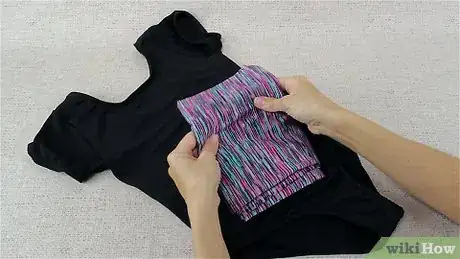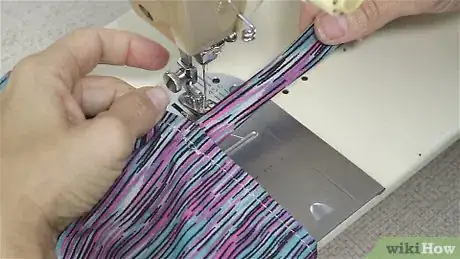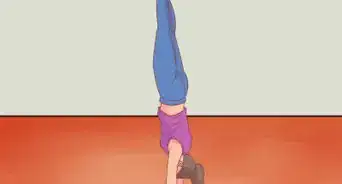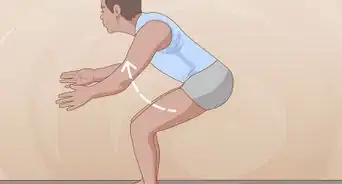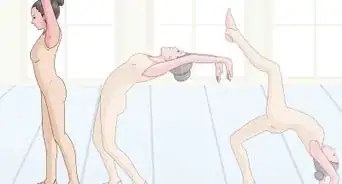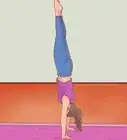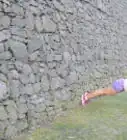This article was co-authored by Seleh Rahman. Seleh Rahman is a Tailor, Furrier, and the Owner of Seleh de Federal Hill in Baltimore, Maryland. With over 45 years of experience, Seleh specializes in fur, alterations, and fashion illustration. Seleh studied Fashion Design and Tailoring at Bay College of Maryland. He holds certifications in fur, design, and tailoring.
There are 13 references cited in this article, which can be found at the bottom of the page.
wikiHow marks an article as reader-approved once it receives enough positive feedback. In this case, 100% of readers who voted found the article helpful, earning it our reader-approved status.
This article has been viewed 50,488 times.
Leotards are essential for gymnastics and ballet, but they can be quite expensive! If you want to make your own leotards, you will save money and you may even find that they fit you better. Start by making a pattern using an existing leotard, and then use the pattern to cut out your fabric and sew the pieces together.
Steps
Creating the Leotard Pattern
-
1Choose a leotard that fits you well to create your pattern. You can use an old leotard with sleeves to make a pattern for your new leotard. Make sure that the leotard you use fits you (or the person who will wear the leotard) well.[1]
- A 1 piece swimsuit will also work if you do not have a leotard.
Tip: You can also purchase a pattern in a craft supply store if you prefer. This will allow you to choose the size and style of your leotard.
-
2Fold the leotard in half lengthwise and trace the outline. Position the folded leotard so that the front side is visible and the sleeves are stacked on top of each other. Fold the sleeves in to trace the body of the leotard. Then, place the leotard onto the pattern or butcher paper. Use a pen or pencil to create an outline of the folded leotard body. Then, unfold the sleeves and trace around these separately to create a sleeve pattern.[2]
- Make sure to trace right along the edges of the leotard.
Advertisement -
3Measure and draw a line 0.5 in (1.3 cm) from the edges. Use a ruler or tape measure to find this location along the edges of the leotard body and sleeves. Then, draw a line with a piece of chalk that follows the outline of the leotard. This will provide the seam allowance for your leotard and sleeves.[3]
- Make sure that the line goes all the way around the edges of the leotard body and sleeves.
- Cut out this piece and mark it as the "front" piece.
-
4Repeat to create a pattern for the back of the leotard. Fold the leotard in the opposite direction and use a pen or pencil to trace the outline.[4] Then, draw a second line 0.5 in (1.3 cm) outside of the outline for the seam allowance.[5]
- Keep in mind that the back of the leotard may have a lower back than the front.
- Make sure to write "back" on the back piece to indicate what it is.
-
5Draw the straps plus a 0.5 in (1.3 cm) seam allowance. If the leotard is a tank top style, then you will not need to do this part. If the leotard has straps, then use a ruler or measuring tape to measure their length and width. Then, add the seam allowance and draw a strap onto the paper.[6]
- For example, if the straps are 11 by 1.5 in (27.9 by 3.8 cm), then draw a strap that measures 11.5 by 2 in (29.2 by 5.1 cm).
- Cut out this piece and mark it to indicate that it is the pattern for your straps.
Cutting Out the Leotard Pieces
-
1Choose 2 yd (1.8 m) of fabric that has some give to it. A stretch fabric such as lycra, spandex, or stretch cotton will work well for making a leotard. It is important for the fabric to have some give, but it should also be strong and durable. Select fabric in the color or print of your choice.
- You may only end up needing around 1 yd (0.91 m) to make your leotard, but get 2 yd (1.8 m) just in case!
-
2Place the pattern pieces on the folded fabric. Fold the fabric in half lengthwise and then place the front and back body and sleeve pattern pieces on the fabric. Align the long, straight edges of the front, back, and sleeve paper pattern pieces with the folded edge of the fabric. Position the strap pattern (if using) away from the folded edges.[7]
- Make sure that there are no lumps or bumps in the fabric before you place the pattern pieces on it.
-
3Pin or place weights around the outer edges of the pattern pieces. If you use pins, insert a pin every 2 to 3 in (5.1 to 7.6 cm) along the edges of the pattern pieces. If you use pattern weights, place a weight about every 3 to 4 in (7.6 to 10.2 cm) along the edges of the pattern pieces.[8]
- Make sure to insert the pins so that they are perpendicular to the edges of the fabric. This will make it easier to remove them when you sew the leotard.
-
4Cut along the edges of the pattern pieces with a sharp pair of scissors. Use the outside of each of the paper pattern pieces as your guides. Cut out a front and back piece along the fold, but do not cut through the folded fabric. Cut the straps all the way around (if using).[9]
- Be careful not to create any jagged or crooked edges! This will interfere with sewing.
Tip: Only use fabric scissors to cut your fabric! Don’t use the same scissors you used to cut out the paper pattern.
Sewing the Leotard
-
1Pin the front and back leotard body pieces together. Make sure that the right (print or front) sides are facing each other. Line up the sides, leg openings, and crotch portions of the front and back pieces.[10]
- Do not pin along the leg openings, armholes, or neckline. These must remain open!
-
2Sew a zigzag stitch along the sides, crotch, and shoulders. Do not sew the neck, arm, and leg openings closed! Set your sewing machine to the zigzag stitch setting. Then, place the pinned leotard pieces under the presser foot. Lower the presser foot and apply gentle pressure to the pedal to start sewing. Sew all the way across the edges and then press the reverse lever to backstitch by about 0.5 in (1.3 cm).[11]
- Remove the pins as you sew. Do not sew over them or you may damage your sewing machine!
-
3Fold the straps or sleeves in half lengthwise and sew 0.5 in (1.3 cm) from the raw edges. Ensure that the right (front or print) sides are together and the wrong (back or non-print) sides are facing out. Continue using the zigzag stitch to sew along the raw edges of each of the straps to connect the raw edges. Leave the short ends of the straps open.[12]
- Make sure to remove the pins as you sew.
- Keep in mind that you can skip the straps or sleeves if your leotard has a tank top style.
-
4Attach the straps to the top corners of the front and back pieces. Invert the straps and the leotard so that the right sides are facing out. Pin the end of 1 strap to the topmost corner of the leotard. Make sure that the end of the strap is hidden on the inside of the leotard. Sew a zigzag stitch across the end of the strap, and then press the reverse lever to backstitch across the end of the strap.[13]
- Repeat this for each of the straps.
- Make sure that you do not sew the arm or neck opening closed as you do this!
- Cut any loose threads where you have attached the straps.
-
5Pin and sew the sleeves onto the armholes. Turn the leotard body inside out and insert the sleeve arm-first into the leotard. Match up the seam on the armpit area of the leotard with the seam on the armpit area of the sleeve. Place a pin every 2 to 3 in (5.1 to 7.6 cm) all the way around the armhole and sleeve with the right sides together and the raw edges even. Then, sew a zigzag stitch around the edges of the sleeve to secure the sleeve onto the leotard body.[14]
- Make sure to remove the pins as you sew.
- Repeat for the other sleeve to complete your leotard.
- Trim the excess threads after you finish sewing, and then turn the leotard right side out.
Want to add some extra sparkle to your leotard? Embellish your leotard by gluing crystals onto the front, sewing on an applique, or adding a lace or ribbon trim to the neckline.
Community Q&A
-
QuestionWhat fabric is used for leotards?
 Drew Hawkins1Community AnswerStretchy fabrics such as lycra, spandex, or stretch cotton are used to make leotards.
Drew Hawkins1Community AnswerStretchy fabrics such as lycra, spandex, or stretch cotton are used to make leotards. -
QuestionHow do you make a long sleeve leotard?
 Drew Hawkins1Community AnswerFold a leotard in half lengthwise and trace the pattern on paper. Then, measure the length of one of your arms and add it to the outline you traced so you can incorporate it into your design.
Drew Hawkins1Community AnswerFold a leotard in half lengthwise and trace the pattern on paper. Then, measure the length of one of your arms and add it to the outline you traced so you can incorporate it into your design. -
QuestionCan you use a swimsuit as a leotard?
 Drew Hawkins1Community AnswerNo, a swimsuit won't work as well as a leotard. Even though a swimsuit and a leotard may look and feel similar, a swimsuit will not stretch or perform as well as a leotard if used for sports such as gymnastics. It is designed for swimming, the other for stretching exercise and dance.
Drew Hawkins1Community AnswerNo, a swimsuit won't work as well as a leotard. Even though a swimsuit and a leotard may look and feel similar, a swimsuit will not stretch or perform as well as a leotard if used for sports such as gymnastics. It is designed for swimming, the other for stretching exercise and dance.
Things You’ll Need
- A leotard or leotard pattern
- 1 to 2 yd (0.91 to 1.83 m) of stretch fabric (depending on the size of the leotard you’re making)
- Pattern paper or butcher’s paper
- Ruler or measuring tape
- Scissors
- Pen or pencil
- Pins
- Sewing machine
- Thread
References
- ↑ https://www.youtube.com/watch?v=R5NhX3jFvck&feature=youtu.be&t=47
- ↑ https://www.youtube.com/watch?v=R5NhX3jFvck&feature=youtu.be&t=74
- ↑ https://www.youtube.com/watch?v=R5NhX3jFvck&feature=youtu.be&t=150
- ↑ https://www.youtube.com/watch?v=R5NhX3jFvck&feature=youtu.be&t=175
- ↑ https://www.youtube.com/watch?v=R5NhX3jFvck&feature=youtu.be&t=207
- ↑ https://www.youtube.com/watch?v=R5NhX3jFvck&feature=youtu.be&t=247
- ↑ https://www.youtube.com/watch?v=HBVzPd9rs9k&feature=youtu.be&t=289
- ↑ https://www.youtube.com/watch?v=luEPmlRrPtk&feature=youtu.be&t=36
- ↑ https://www.youtube.com/watch?v=luEPmlRrPtk&feature=youtu.be&t=41
- ↑ https://www.youtube.com/watch?v=HBVzPd9rs9k&feature=youtu.be&t=289
- ↑ https://www.youtube.com/watch?v=luEPmlRrPtk&feature=youtu.be&t=120
- ↑ https://www.youtube.com/watch?v=luEPmlRrPtk&feature=youtu.be&t=66
- ↑ https://www.youtube.com/watch?v=luEPmlRrPtk&feature=youtu.be&t=205
- ↑ https://www.youtube.com/watch?v=pcGJuOkZ_ik&feature=youtu.be&t=196
About This Article
To make a leotard, get a leotard pattern and 2 yards of stretch fabric like lycra, spandex, or stretch cotton from your local craft supply store. Once you have these supplies, fold the fabric in half lengthwise and place the pattern pieces on it. Use scissors to cut the fabric around these patterns. After you cut the fabric, pin the front and back pieces together with the right sides facing each other. With a zigzag stitch, sew along the sides, crotch and shoulders. Remember not to sew the arm, leg, and neck openings closed! After you’ve sewn these sections, fold the sleeves in half lengthwise and sew along the edges to connect them. When your sleeves are done, attach them to the top corners of the front and back pieces. Turn the leotard body inside out and sew the sleeves onto the armholes. For more help, including how to create your own leotard pattern, read on!
